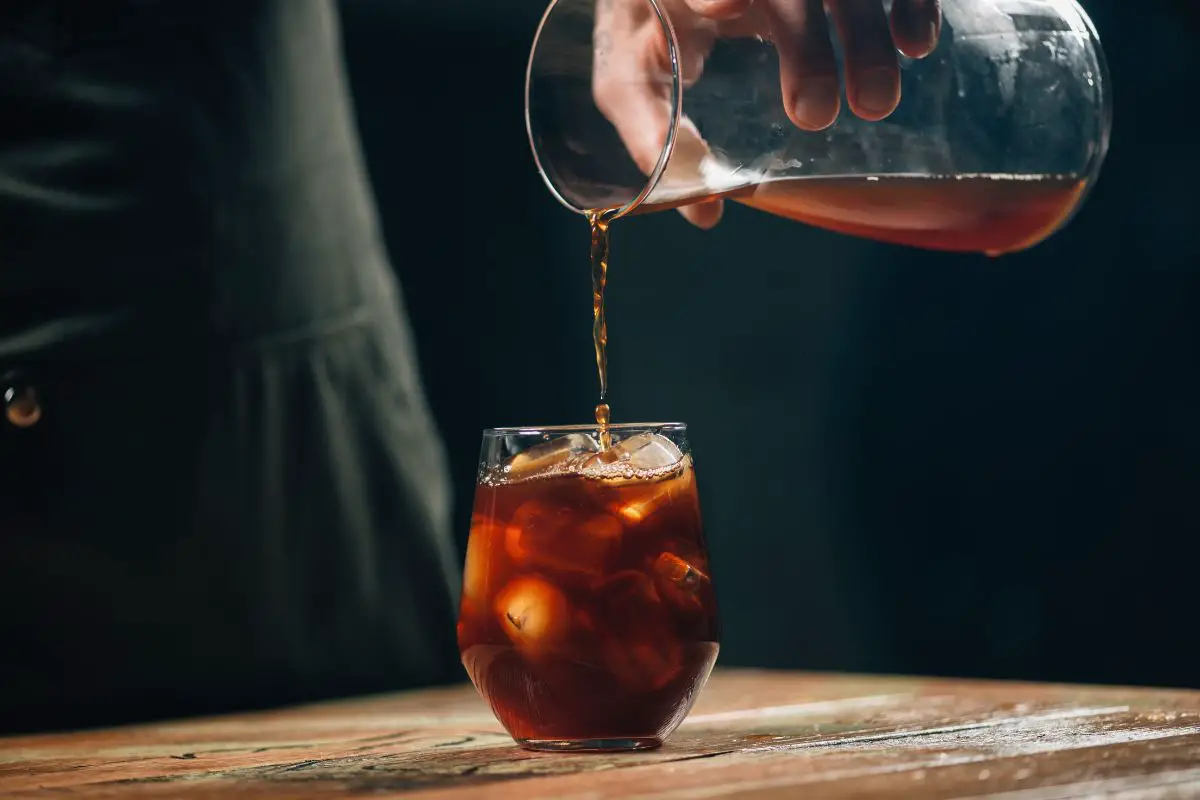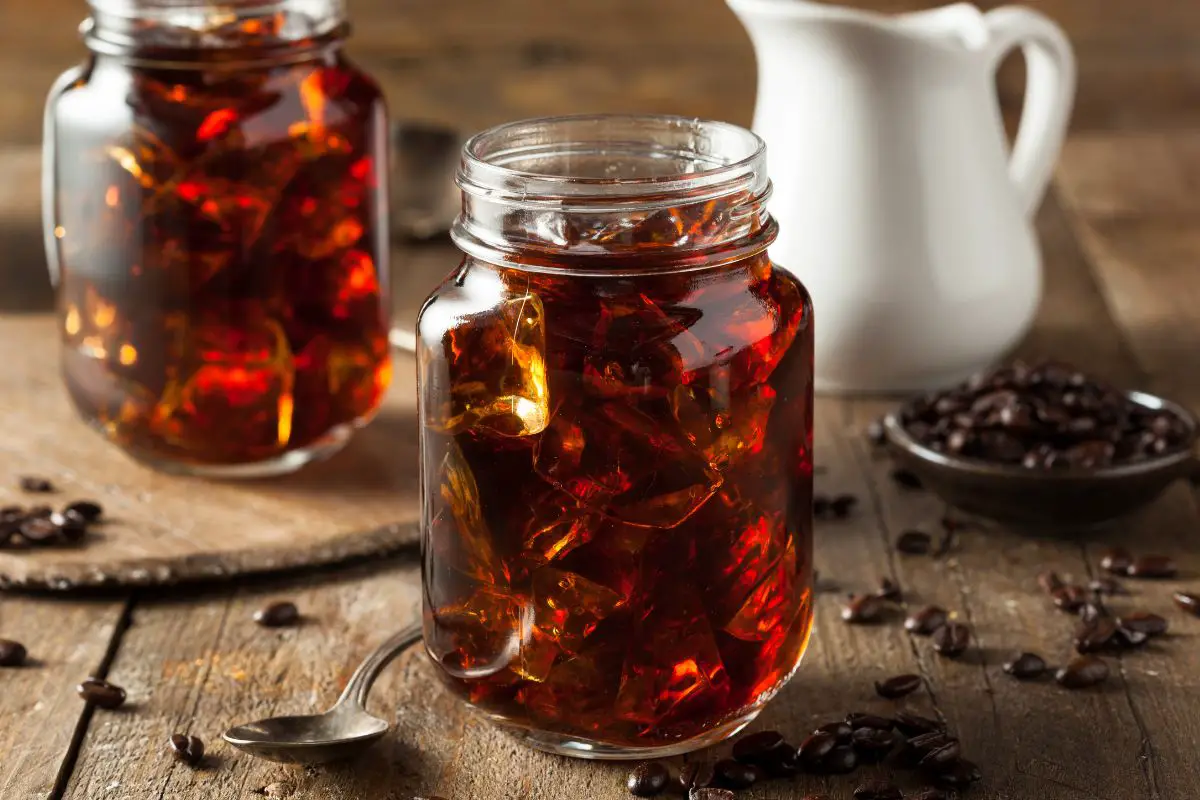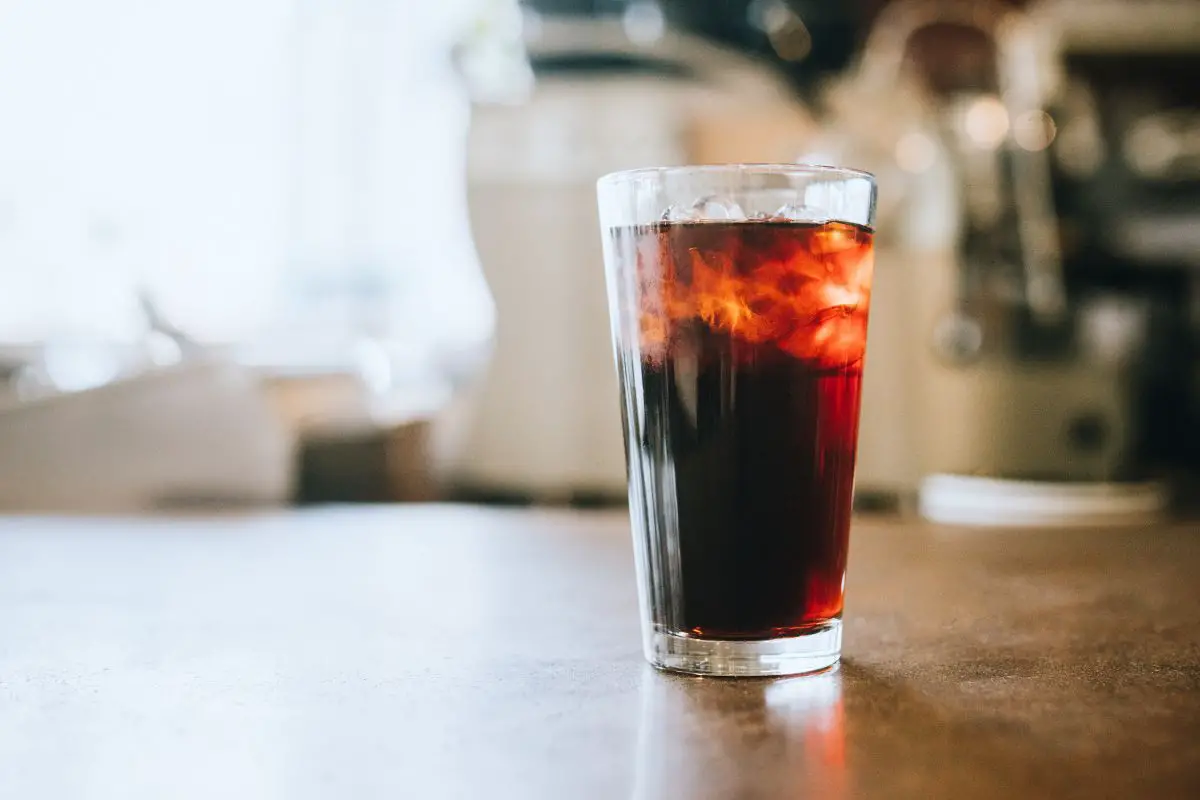In the world of coffee, the phrase ‘time flies’ holds true for the delightful experience of sipping on a cup of cold brew. But have you ever wondered how long this refreshing beverage can stay fresh and safe to consume?

In this article, we will delve into the topic of the shelf life of cold brew coffee, examining the factors that can affect its longevity and exploring the signs of spoilage. By understanding these aspects, you will be equipped with knowledge to ensure the safety and enjoyment of your cold brew.
So, if you’re someone who values the importance of consuming safe and fresh beverages, join us as we uncover the secrets of how long cold brew lasts and discover useful tips to extend its shelf life.
Key Takeaways
- Cold brew coffee should be stored at a temperature below 40°F (4°C) to prevent bacterial growth.
- Glass or stainless steel containers are recommended for storing cold brew to avoid unwanted flavors.
- Proper storage techniques, such as using a clean, airtight container in the refrigerator, can extend the shelf life of cold brew.
- Cold brew should be consumed within 7-10 days to minimize the risk of mold growth and maintain its quality.
What is Cold Brew Coffee?
Cold brew coffee is a popular beverage that is made by steeping coarsely ground coffee beans in cold water for an extended period of time, resulting in a smooth and less acidic flavor profile.
Unlike traditional hot brewing methods, which involve exposing coffee grounds to hot water for a short duration, cold brew involves a slow extraction process that occurs over several hours or even overnight.
This extended steeping time allows for the gradual release of coffee’s flavors, resulting in a more mellow and less bitter taste. The coarsely ground coffee beans used in cold brew also contribute to the beverage’s smoothness, as they produce less sediment and fewer bitter compounds compared to finely ground coffee.
Additionally, the cold water used in the brewing process helps to reduce the extraction of certain compounds that can contribute to acidity in coffee. As a result, cold brew coffee is often described as having a lower acidity level, making it a favorable choice for individuals with sensitive stomachs or acid reflux issues.
Understanding the process by which cold brew coffee is made is essential in exploring the factors that affect its shelf life.
Factors Affecting Cold Brew Shelf Life
This discussion will explore the factors that can affect the shelf life of cold brew coffee, namely temperature, storage container, and exposure to oxygen.
The temperature at which cold brew coffee is stored can significantly impact its longevity, as higher temperatures can accelerate the deterioration of the coffee’s flavor and quality.
The choice of storage container is also crucial, as airtight containers can help minimize the coffee’s exposure to oxygen, which can lead to oxidation and the development of off-flavors.
Temperature
Chilling the cold brew significantly extends its shelf life, allowing it to maintain its freshness for an impressively extended duration. Temperature plays a crucial role in preserving the quality of cold brew.
Cold brew should be stored at a temperature below 40°F (4°C) to prevent the growth of bacteria and other microorganisms. The lower temperature slows down the chemical reactions that cause the deterioration of the coffee, such as oxidation and degradation of flavors.
To ensure the longevity of cold brew, it is important to store it in a refrigerator or cooler. Additionally, using airtight containers can help maintain the desired temperature and prevent the absorption of odors from the surrounding environment. Proper temperature control not only ensures the safety of consuming cold brew but also helps to retain its rich and smooth flavor.
Moving on to the next section about storage containers, it is important to consider the impact of the container material on the cold brew’s shelf life and taste.
Storage Container
The choice of storage container for cold brew can greatly impact its preservation and taste. It is crucial to choose a container that is airtight and able to maintain a consistent temperature.
Glass containers are often recommended for storing cold brew as they do not retain odors or flavors from previous uses, and they are also non-reactive, ensuring that the taste of the cold brew remains unchanged. Additionally, glass containers provide a clear view of the contents, allowing for easy monitoring of any potential spoilage.
Stainless steel containers are also a viable option, as they are durable, easy to clean, and can maintain the desired temperature.
However, it is important to avoid containers made of plastic or other materials that may impart unwanted flavors or chemicals to the cold brew.
Moving onto the next section about exposure to oxygen, it is important to consider how this factor can affect the quality and shelf life of cold brew.
Exposure to Oxygen

Exposure to oxygen can significantly impact the quality and shelf life of cold brew, as it introduces oxidative reactions that can alter the taste and aroma of the beverage. Oxygen acts as a catalyst for chemical reactions, leading to the degradation of organic compounds present in cold brew.
The primary compounds affected by oxygen exposure are the volatile aromatic compounds responsible for the pleasant aroma of cold brew. These compounds can oxidize, resulting in a loss of aroma and a stale taste. Additionally, oxygen can promote the growth of bacteria and molds, leading to spoilage and potential health risks.
To mitigate the negative effects of oxygen exposure, it is crucial to store cold brew in airtight containers and minimize the time it is exposed to air. Proper storage practices will help preserve the quality and extend the shelf life of cold brew.
Transitioning to the next section, let’s now discuss how long cold brew can last under ideal conditions.
How Long Does Cold Brew Last?
When stored properly, cold brew can maintain its freshness and quality for up to two weeks. The key to preserving cold brew is to minimize its exposure to oxygen. Oxygen can cause the deterioration of the compounds in cold brew, leading to changes in taste, aroma, and overall quality.
To extend the shelf life of cold brew, it is essential to store it in an airtight container, such as a glass jar with a tight lid or a sealed bottle. This helps to prevent oxygen from coming into contact with the cold brew, reducing the rate of oxidation.
Additionally, it is recommended to keep cold brew refrigerated at all times. Cold temperatures help to slow down the growth of bacteria and other microorganisms that can spoil the beverage.
It is important to note that even with proper storage, the flavor of cold brew may gradually change over time. After two weeks, the taste and aroma may become less appealing, and the quality may start to decline. Therefore, it is advisable to consume cold brew within this two-week window to enjoy it at its best.
In the next section, we will discuss the signs of spoiled cold brew and how to identify if your cold brew has gone bad.
Signs of Spoiled Cold Brew
This paragraph introduces a discussion on signs of spoiled cold brew, specifically focusing on two key points: change in flavor and aroma and mold growth.
When cold brew coffee spoils, it often exhibits a noticeable change in flavor and aroma. The once smooth and rich taste can become sour or funky, while the pleasant aroma may turn musty or unpleasant.
Additionally, mold growth is a common sign of spoiled cold brew, which can be observed as dark spots or patches floating on the surface or settled at the bottom of the container.
Change in Flavor and Aroma
Cold brew coffee undergoes changes in flavor and aroma as it ages. These changes can be indicative of the cold brew coffee becoming spoiled. Here are four key signs to look out for:
- Bitterness: Over time, cold brew coffee may develop a more bitter taste. This can be a result of the coffee grounds steeping for too long or the presence of oxidation.
- Stale or Flat Taste: As cold brew coffee ages, it may lose its vibrant and refreshing taste. The flavors become less pronounced, and the coffee may taste flat or dull.
- Off-putting Odor: Spoiled cold brew coffee may emit a foul smell, similar to that of rotten or fermented food. This can be a sign of bacterial growth or contamination.
- Sour or Vinegary Taste: If the cold brew coffee has a sour or vinegary taste, it is likely spoiled. This can occur when the coffee is left at room temperature for an extended period, allowing for the growth of harmful bacteria.
Understanding these changes in flavor and aroma can help ensure the safety and enjoyment of your cold brew coffee. Transitioning into the next section, it is important to address the potential risk of mold growth.
Mold Growth
Mold growth in coffee poses a potential health risk and can significantly impact the overall quality of the beverage. Cold brew, being a favorable environment for mold due to its low acidity and absence of heat, is particularly susceptible to mold growth. Mold can develop when the cold brew is not properly stored or when it is left at room temperature for an extended period. Consuming mold-contaminated cold brew can lead to various health issues, such as allergic reactions and respiratory problems.
To ensure safety and maintain the quality of cold brew, it is crucial to store it in a clean, airtight container in the refrigerator. Additionally, it is recommended to consume cold brew within 7-10 days to minimize the risk of mold growth and to enjoy the beverage at its best.
Tips for Extending the Shelf Life
This discussion will focus on two key points for extending the shelf life of cold brew: proper storage techniques and using air-tight containers.
Proper storage techniques play a crucial role in preserving the freshness of cold brew. Storing cold brew in the refrigerator, away from light and heat, helps to maintain its quality for a longer period.
Additionally, using air-tight containers prevents oxygen exposure, which can lead to oxidation and spoilage of the cold brew.
Proper Storage Techniques
Proper storage techniques ensure the longevity of cold brew, allowing it to retain its freshness and flavor for an extended period of time. To maximize the shelf life of cold brew, it is important to follow these guidelines:
- Use a clean, airtight container: This will prevent exposure to air and moisture, which can lead to oxidation and the growth of bacteria.
- Store in the refrigerator: Cold brew should be kept at a temperature below 40°F (4°C) to inhibit bacterial growth and maintain its quality.
- Avoid direct sunlight: UV rays can degrade the flavor and quality of cold brew, so it is best to store it in a dark place.
By following these storage techniques, cold brew can remain fresh and flavorful for up to two weeks.
Using air-tight containers ensures that the coffee is protected from external factors, which will be discussed in the subsequent section.
Using Air-tight Containers
Proper storage techniques play a crucial role in maintaining the freshness and quality of cold brew coffee. One method that is highly recommended is the use of air-tight containers. These containers create a barrier that prevents oxygen from seeping in and coming into contact with the cold brew.
Oxygen exposure can lead to oxidation, which can cause the coffee to become stale and lose its flavor. By using air-tight containers, you can effectively prolong the shelf life of your cold brew. These containers should be made of glass or stainless steel, as they are non-porous materials that do not absorb odors or flavors.
Additionally, it is important to keep the containers in a cool and dark place, away from direct sunlight and heat sources. This will further contribute to preserving the freshness of the cold brew.
Transitioning to the next section, let us now explore the ways to enjoy fresh cold brew coffee.
Enjoying Fresh Cold Brew

To fully appreciate the optimal taste of fresh cold brew, it is recommended to consume it within the first few days of brewing.
Cold brew is a delicate beverage that can easily spoil if not handled properly. While using air-tight containers can help prolong its freshness, it is important to note that even with this precaution, the taste and quality of cold brew may deteriorate over time. Oxidation, temperature fluctuations, and exposure to light can all contribute to the degradation of cold brew, leading to a less enjoyable drinking experience.
To ensure the safety and enjoyment of cold brew, it is crucial to store it in a refrigerator at a consistent temperature of 38 to 40 degrees Fahrenheit. This helps slow down the growth of bacteria and preserves the freshness of the beverage. Additionally, keeping the cold brew away from direct sunlight and other strong odors can further prevent the deterioration of its taste.
It is worth mentioning that consuming cold brew beyond the recommended few days does not necessarily pose a health risk. However, the flavor and aroma may become less pronounced, and the overall quality may diminish. Therefore, for those who desire a consistently safe and enjoyable cold brew experience, it is best to consume it within the first few days of brewing while it is still fresh and at its peak.
Frequently Asked Questions
Can I use flavored coffee beans to make cold brew?
Flavored coffee beans can be used to make cold brew, adding a touch of novelty to the beverage. However, it is important to note that the flavor may not be as strong as with hot brewing methods due to the longer steeping time.
Does cold brew have more caffeine than regular coffee?
Cold brew coffee typically has more caffeine than regular coffee due to the longer brewing process and higher coffee-to-water ratio. However, the exact caffeine content can vary depending on factors such as the type of coffee beans used and the brewing method.
Can I store cold brew in a stainless steel container?
Storing cold brew in a stainless steel container is safe and can help maintain its freshness. However, the storage duration depends on various factors, such as temperature and cleanliness. To determine how long cold brew lasts, it is essential to consider the context of storage conditions.
Can I add milk or cream to my cold brew?
It is safe to add milk or cream to cold brew. However, it is important to note that the addition of dairy products may shorten the shelf life of the cold brew, so it should be consumed within a few days.
Is it safe to consume cold brew that has been left out overnight?
It is not safe to consume cold brew that has been left out overnight. Bacteria can grow rapidly in the warm temperature, potentially causing foodborne illnesses. Proper refrigeration is necessary to ensure safety.
Conclusion
Cold brew coffee is a popular beverage with a unique flavor profile. Its shelf life, however, is influenced by several factors such as storage conditions and the presence of additives. On average, cold brew can last up to two weeks when refrigerated, but it may start to lose its flavor and freshness after a week.
Signs of spoiled cold brew include a sour or off-putting smell and taste. To extend its shelf life, store it properly in an airtight container and avoid adding any dairy or sweeteners until you’re ready to consume it.
Enjoying fresh and delicious cold brew is possible with proper storage and handling techniques.
Related article: